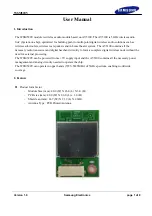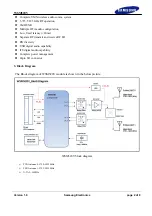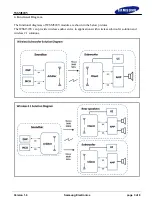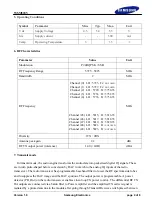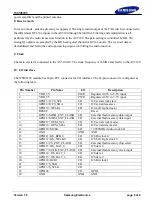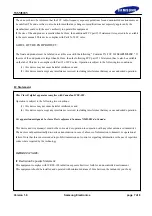
WSM520V
Version 1.0
Samsung Electronics
page 4 of 8
5. Operating Conditions
Symbol Parameter
Min. Typ. Max.
Unit
V dc
Supply Voltage
4.5
5.0
5.5
V
I dc
Supply current
-
-
500
mA
Temp Operating
Temperature
5 35
℃
6. RF Characteristics
Parameter Value
Unit
Modulation
Pi/4DQPSK
/ SSB
RF Frequency Range
5725 – 5825
MHz
Bandwidth 2
MHz
RF Frequency
Channel (0) LO : 5725, Fc:
NOT USED
Channel (1) LO : 5727, Fc:
NOT USED
Channel (2) LO : 5729, Fc: 5730.35
Channel (3) LO : 5731, Fc: 5732.35
Channel (4) LO : 5733, Fc: 5734.35
.
.
.
.
.
.
Channel (45) LO : 5815, Fc: 5816.35
Channel (46) LO : 5817, Fc: 5818.35
Channel (47) LO : 5819, Fc: 5820.35
Channel (48) LO : 5821, Fc:
NOT USED
Channel (49) LO : 5823, Fc:
NOT USED
MHz
Diversity
1TX / 2RX
Antenna peak gain
2.2
dBi
RF TX output power (tolerance)
14.0 (+2dB)
dBm
7. Transmit mode
In transmit mode, the audio engine transforms the audio data into packetized digital IQ signals. These
are in turn pulse-shaped before conversion by DAC to match to the analog IQ inputs of the radio
transceiver. The radio transceiver has programmable baseband filter to lower the RF spectrum side lobes
and to suppress the DAC image and the DAC spurious. The output power is programmable. A power
detector (PD_Out) on the radio transceiver enables close-loop TX power control. The differential RF TX
DA outputs are connected via a balun filter to Power amplifier and the amplified TX carrier signal is
radiated by a printed antenna in the module after going through Transmit/Receive switch placed between

